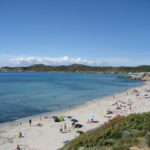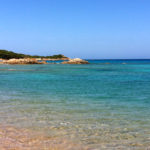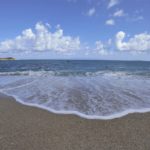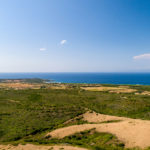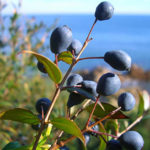Aglientu and the territory.
At just a few kilometres from the sea, Aglientu rises in an area of mainly granite stone, with a landscape marked by majestic masses of rock and green valleys converging on the sea, descending every now and then to sandy beaches with high dunes and at other times to imposing cliffs. Its 22km long coast is quite famous for the beauty of its beaches and its views, which despite the considerable number of tourists has managed to remain unspoilt in long stretches. The name of the village derives from a Latin root meaning “white”, present in numerous other toponyms of the area (“Montagliu”, “Agliacana”, “Frati Agli” and “Agliu”). Man has settled here since the ancient Neolithic as is indicated by the discovery of lithic tools from that era and a number of Nuraghi, such as the “Tuttusoni” and “Finucchjaglia” Nuraghi, are scattered around mainly in the coastal area.
In Roman times a relay station, where horses could be changed, rose in the territory of Aglientu, along the road that led from Porto Torres to S. Teresa di Gallura. The present urban centre originated in 1776, when Vittorio Amedeo III had the Church of San Francesco d’Assisi built. A few decades later the so-called “cucine” were constructed near the church, an area where during feast days all sorts of socioeconomic activities and fairs took place alongside the religious ceremonies. However towards 1850, some of the better-off families started to build proper houses which came to make up the first nucleus of the urban centre. Aglientu was originally a hamlet of Tempio but became an independent commune in 1959.
The Vignola Tower dating back to 1606 and situated in the seaside village with the same name is a typical example of defence fortifications along the Sardinian coast. The tower is a 12 m high truncated cone, rising at 25 m above sea level on a gentle granite slope and which offers a wonderful view both the sea and the hinterland. There are numerous country churches in the territory of Aglientu. Of these the most ancient is the Church of San Pancrazio, at 5 km from the inhabited centre and dating back to the end of the seventeenth century. The Church of San Biagio rises, at 6 km from the village on the road for Tempio, erected in 1967 in place of a previous building for worship. Inside, the Statue of San Biagio is preserved, dating back to the XV-XVI century and sculpted from a single piece of pear wood by Sardinian craftsmen.
The Church of San Giovanni dates back to 1930 and last but not least, the Church of San Silverio was built at the end of the thirties by the fishermen of Ponza, near the Portobello Marina in a remote area close to the sea. However, Aglientu’s main attractions are its coasts, where the fairly wide-stretching sandy dunes plunge into the sea and conjure up images of desolate landscapes alternating with high rocky headlands, like those of Mount Russu (90 m), in pink granite with a rounded shape extending towards the Gulf of Asinara. Among the longest stretches of beach “Lu Litarroni”, “Vignola” and “Rena Majore” are worth a mention. There are several summer festivals which attract thousands of tourists from the coasts, like the “Seadas” Festival, (the typical sweet made with cheese and spread with honey), held on the last Saturday of June, or the “Sausage and Cheese” Festival held on 12th August. Instead on 25th January, celebrations are held for San Paolo of Lu Laldu in the country Church of San Pancrazio, where typical food is offered to all the guests and then on 2nd February, the Feast of San Biagio is celebrated with a dinner for the whole community.


